Duration: 2 hours 19 minutes | Lessons: 16
In a little over two hours of lessons, you’ll get the lowdown on how WordPress works, how to install it, how to create a new website, customize it, and more. So let’s not delay any longer – let’s jump right in!
Introduction
Welcome to the Course
WordPress is one of the most powerful content management systems currently available. In fact, it’s versatile, constantly updated, and totally free. And with it you can create simple blogs, large and complex websites, and anything in between. Which is a pretty great combo if you ask us.
Learning how to use it without prior experience can be a challenge, however. Hence the nature of this course! In it, we’ll walk you through every little step you need to take to get familiar with WordPress. After completing this course, you should be comfortable with:
- Installing WordPress
- Adding new content
- Customizing themes
- Installing plugins
- Managing existing blogs or websites
Now, this course is rather large, so it’ll be split up into a handful of dedicated sections. These include:
- The Basics: This covers everything from installing WordPress to navigating the dashboard
- Content Management: Here we discuss how to add posts and pages, upload media, manage comments, and build menus.
- Customization, Plugins, and Settings: Precisely what it says on the tin — we talk about how to customize WordPress core and themes, install plugins, move users, and more.
The Basics
1. What is WordPress?
In this lesson, we cover all the basics of getting started with WordPress with the assumption you know absolutely nothing about it. In it, you’ll learn:
- A definition of what WordPress is
- Where you can get and download WordPress
- A good rundown of all the things you can do and accomplish with WordPress
- The difference between WordPress.com and WordPress.org
2. Installing WordPress Locally
In the second lesson of this course, we dive into the details of how to install WordPress locally on your computer. This means any changes you make to your website are only visible to you on your local computer — not on a live website that the whole world can see. This is ideal for the testing and development phase of web design.

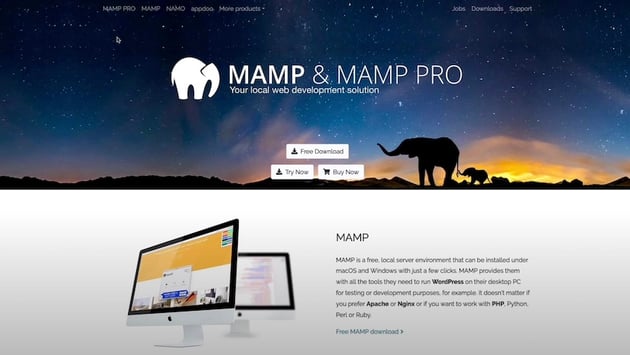
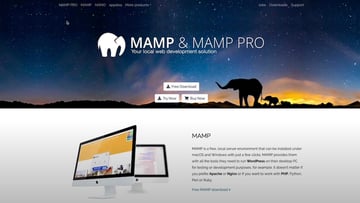
This lesson also covers the software you need to make this installation (and where to find them) including MAMP or XAMPP. This software is used to create a local server.
You’ll use this tool to access PHPMyAdmin. You’ll need this to create a new database for your WordPress installation. Then, you’ll download WordPress and extract the files into the MAMP folder.
From there, you’ll go through the WordPress installation process where you’ll configure it and establish a username and password.
3. Installing WordPress on a Live Server
With the knowledge of how to install WordPress on a local server under your belt, installing it on a live server should be a piece of cake. Installing WordPress on a live server means that everyone else can see your site once published — not just you. And it’ll be accessible via a URL.
This lesson also delves into the differences between local and live servers in greater detail and covers all the necessary steps for publishing your website with WordPress. This includes the prerequisites you need before publishing including
- A domain name
- Web hosting
We also go into the specifics of how to configure a web host, including setting up name servers to connect your hosting provider with your domain name.
4. Getting Familiar With the WordPress Dashboard
The very first thing you see when you open the WordPress back-end is the dashboard. This is the starting place for the majority of tasks you’ll be performing in WordPress. It makes sense then why it’s so important to get acquainted with it!
First, we discuss the various ways you can use the dashboard in your workflow. The first panel of the dashboard is made up of various cards give you information, statistics, and links to the most common actions you can make in WordPress.

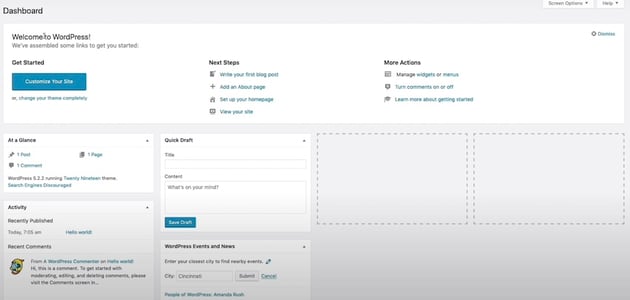

You can also customize the cards or boxes that’ll appear on this first panel by going to Screen Options.
The left sidebar is filled with important links as well to key areas of the WordPress dashboard including updates, posts, media, pages, comments, appearance, and more.
Content Management
5. WordPress Pages vs. Posts
In this first lesson dedicated to content management, you’ll learn everything you need to know about creating and editing posts and pages in WordPress. WordPress is, after all, a CMS or content management system, so this may be one of the most important sections in the entire course.
This lesson truly begins with an explanation of the difference between posts and pages. To summarize: posts display comments and meta data like author name and publish date while pages do not.
Posts
Creating posts is pretty straightforward, as you only need to input a title and content. However, we also review all the features associated with posts including post categories and tags, permalinks, publication schedules, sticky posts, setting a featured image, and more.
Pages
Creating pages in WordPress is very similar to creating a post. In fact, any content that would work in a post will also work for a page. However, you can’t allow comments, set categories, or anything dynamic like that.
6. A Quick WordPress Gutenberg Tutorial
In this lesson you’ll really get to dive into how to use the WordPress editor, called Gutenberg, to create eye-catching content. It is now the default editor.
On the left side of the screen, you have an exact preview of how the page will look when published. When you click on individual elements in the post, however, you will see additional editing options. For instance, clicking on a paragraph block reveals editing options for that block.



You can also click the menu button to see even more options to insert additional blocks, change their order, or what have you. Clicking on a block will also reveal more options on the right hand sidebar for adjusting colors, borders, and additional options.
7. Uploading and Organizing Media
In WordPress, you can upload media files in the Media Library. So in this lesson, we go into detail about how to accomplish this as well as how to organize media files within it. Additionally, you’ll learn how you can use uploaded media in posts and pages.
8. Managing WordPress Comments
Watch video lesson [1:09:18] ↗
Originally WordPress was created as a blogging platform. So it makes sense that comments feature heavily. With this in mind, this lesson focuses on what comments are and how they function as well as how you can manage them effectively.
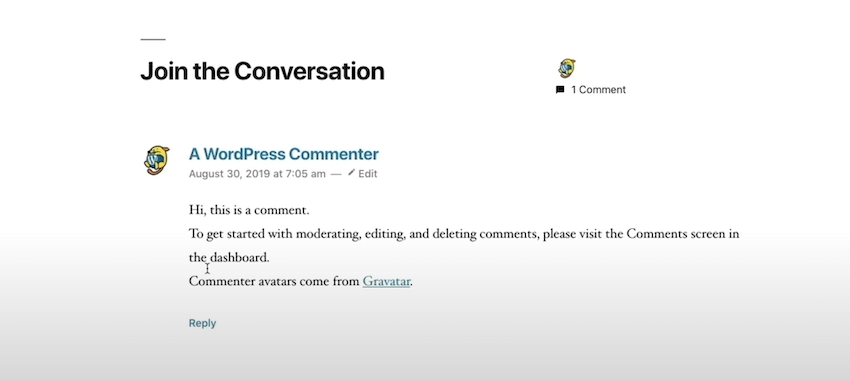

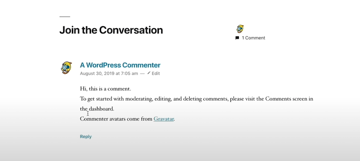
9. Working With WordPress Sidebars and Widgets
Watch video lesson [1:18:31] ↗
Getting further acquainted with all the features WordPress offers, this lesson focuses on how to use sidebars and widgets to provide additional information to your site visitors. To begin, we discuss what sidebars and widgets actually are as well as how to add and remove widgets from your website.
The sidebar is any area on your website that can display widgets. Typically, it appears alongside the main content of a blog post. However, widgetized areas are also often available to you in the site footer.
Widgets are basically small sections you can add to a sidebar that display information. A few default options available to you in WordPress include:
- Recent Posts
- Archives
- Recent Comments
- Categories
10. Building and Maintaining Menus
Watch video lesson [1:24:44] ↗
The last lesson related to content management we discuss here focuses on menus. WordPress makes the task of creating menus really simple. We discuss how to create and edit and menu and then offer tips for using them on your website.
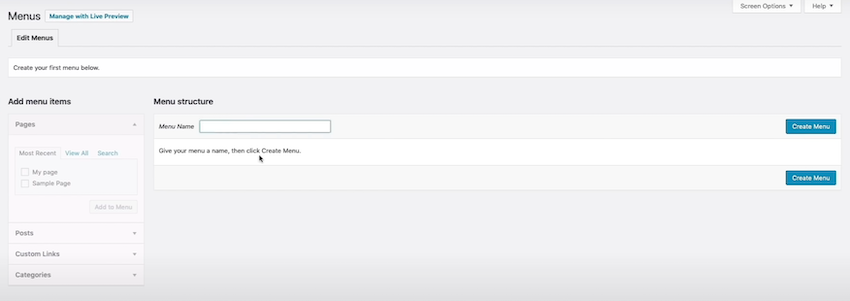
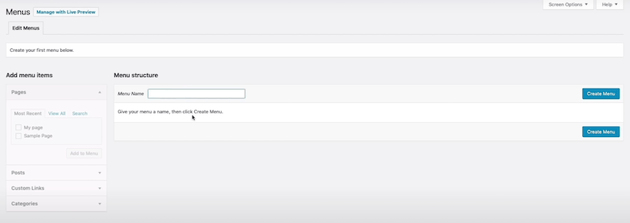
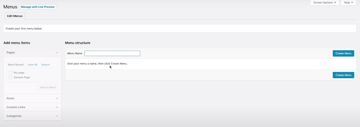
Additionally, you’ll learn the various menu locations available to you depending on your selected theme.
Customization, Plugins, and Settings
11. Using the WordPress Customizer
Watch video lesson [1:30:26] ↗
A huge part of WordPress the ability to customize the look and feel of the actual website you are building. In this lesson, you’ll get acquainted with the WordPress customizer and all the features it has to offer. The Customizer gives you a preview of the actual live site as you make adjustments on the left side.
The key categories available to you in the Customizer include:
- Site Identity
- Colors
- Menus
- Widgets
- Homepage Settings
- Additional CSS
12. Working With Themes
Watch video lesson [1:39:28] ↗
At its core, WordPress is basically a skeleton. You then need a theme on top of that to display the content and to style how your content looks.
So, if you want to completely change how your website looks, you’ll need to change your WordPress theme. Thankfully, there are tons of them available out there — both free and premium. We cover:
- What themes are and how they work
- Where to find WordPress themes
- How to install a theme once you find one you like
- How to modify a theme to better suit your needs or brand
The official WordPress theme directory is an excellent place to find a suitable and free theme for your website.
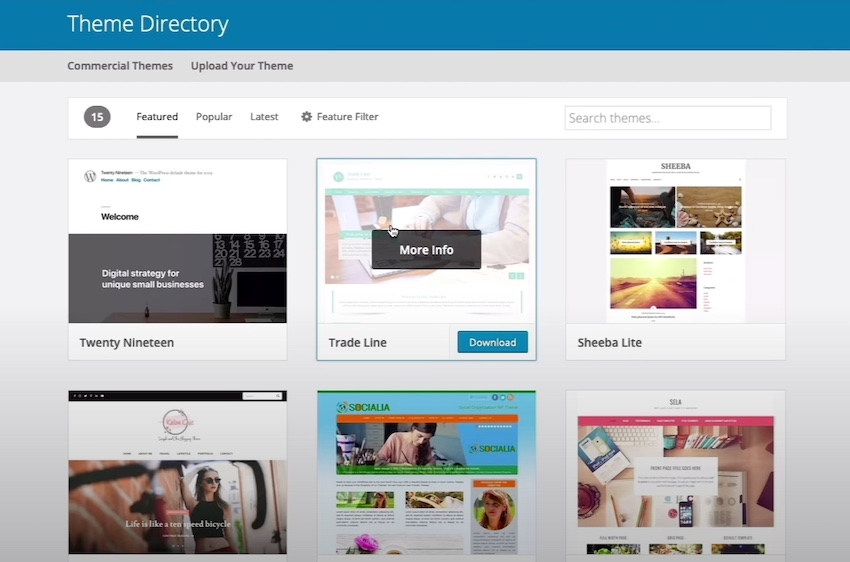
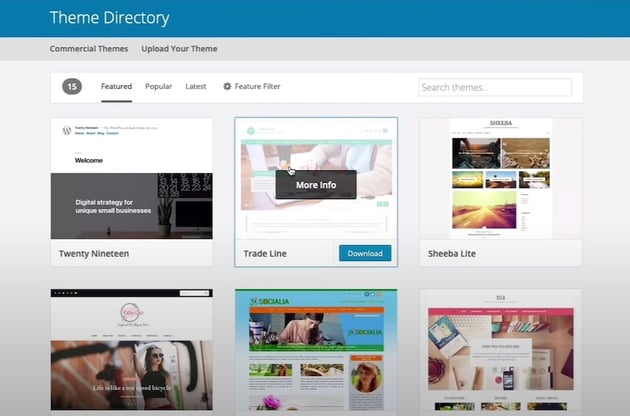

13. Working With Plugins
Watch video lesson [1:52:52] ↗
Another way to customize your WordPress site is to install plugins. A plugin is essentially a piece of software that provides extra functionality to a website. With this in mind, you’ll learn how to access plugins from within the WordPress dashboard, how to install plugins, and then how to manage them once installed.
14. Adding and Managing Users
Watch video lesson [1:58:06] ↗
WordPress starts by default with one user — the admin — but you can have multiple users each with individual permissions based on your needs and requirements. In this lesson, you’ll learn about how to add new users as well as how to manage their user roles and permissions.



The user roles available to you include:
- Subscriber
- Contributor
- Author
- Editor
- Administrator
15. How to Move a WordPress Site
Watch video lesson [2:04:06] ↗
There are cases when you’d want to migrate your WordPress site from one WordPress installation to another. Or, you might want to import certain posts or pages from another website. Either way, there are ways to move a WordPress site and in this lesson, you’ll learn all about the import and export tools available to you in the dashboard. Plus, we showcase the Site Health tool, which can give you insights as to whether or not the migration was successful.
16. Customizing WordPress via Settings
Watch video lesson [2:11:13] ↗
In the last lesson of this course, you’ll learn all about how to customize WordPress via the many available settings. Specifically, within the Settings menu, you’ll gain a good understanding of what options are available to you with regard to:
- General settings
- Writing
- Reading
- Discussion
- Media
- Permalinks
- Privacy
Learn More About WordPress with Even More Tutorials
If you’ve found this course helpful and want to expand your knowledge even further, the following tutorials will help you learn more about WordPress and how to build amazing websites with it.